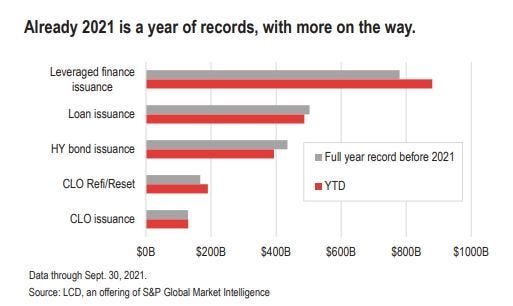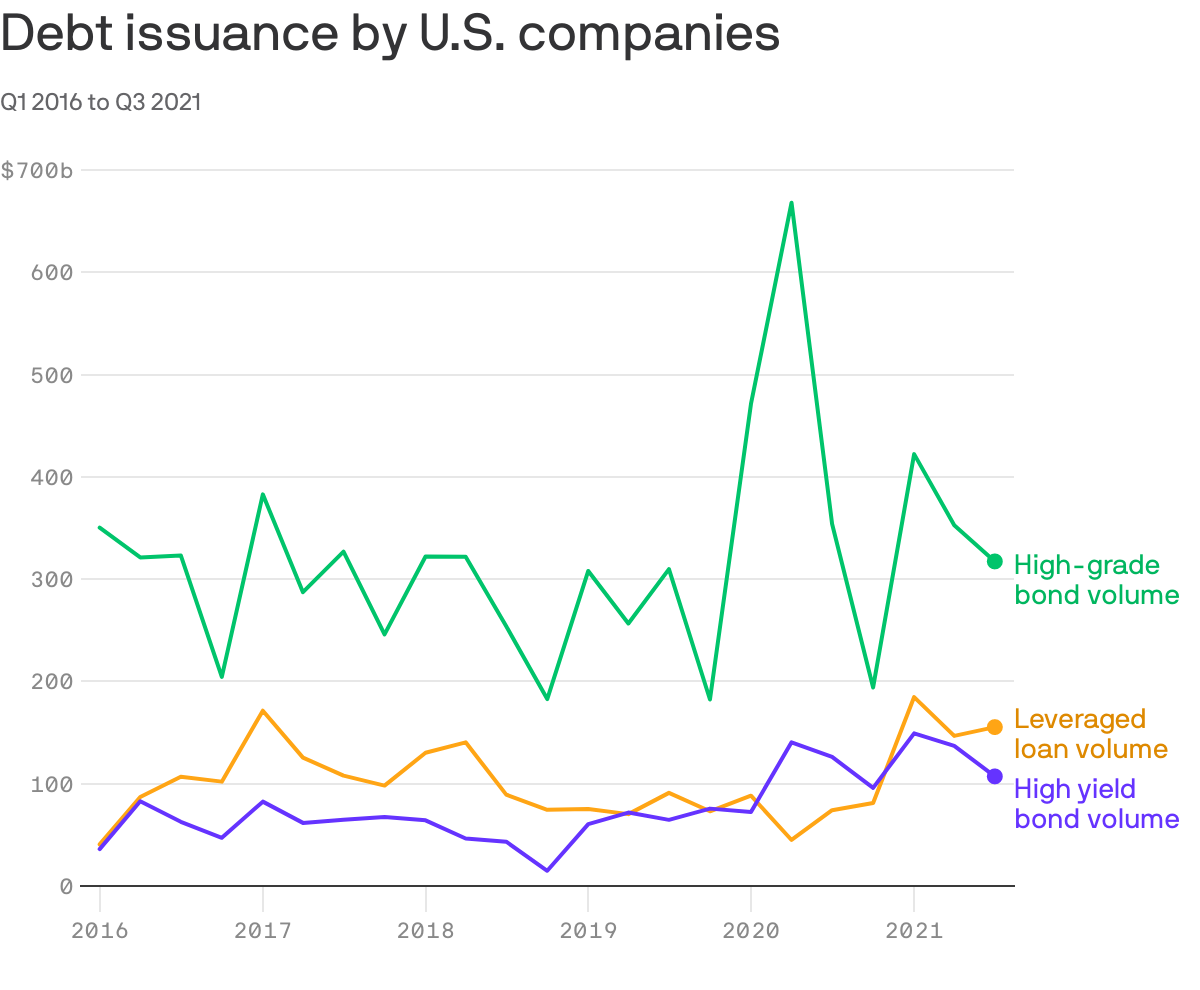👍Winners & Losers of the Week 👎
What a week chock full of winners and losers. Let’s dive in:
Winners
1. The United States of America (Long Kicking the Can). What happens when the risk-free rate underpinning every expected cash flow in the capital markets isn’t actually risk-free? We’re not sure, but the US Senate agreed to raise the debt ceiling $480b so we no longer have to worry about a US government default and us all finding out — for now at least. The theory goes that government bonds are risk-free because the government can, at any time, print more money to pay them off. Some called for the Treasury to mint a trillion-dollar coin to do just that — to use it to buy and retire debt from the Fed. While seemingly legal, the White House shut down this plan, as they do each time this idea percolates into our debt ceiling discourse. Maybe next time, guys.
Still, we’re — and we can’t believe we’re even saying this — not out of the woods yet. All that really happened is that Mitch McConnell and ten other Republicans decided that they’d end the filibuster and let the Democrats vote to kick the can to December 3, 2021 (which also happens to be the deadline for averting a government shutdown). Which the Dems subsequently did. Many high-ranking Republican senators, however, gave McConnell sh*t for it. As did the former President of the United States, Donald Trump. And then Mr. McConnell indicated that there’d be no additional help from the Republicans come December. So, there’s no telling what will happen. As a preview, in a recent note, Moody’s indicated that a default would spark an instant recession, costing the US 6mm jobs, pumping the unemployment rate to 9%, crushing the stock market by 33% and eradicating $15 trillion of household wealth.
We wonder: who in the restructuring community had a US default on their bingo card for what causes the next big wave of distress?
2. Puerto Rico (Long a short Ryan Seacrest). Speaking of raising the roof, Puerto Rico plans to spend some of its $1.5b in federal rescue funds to throw a legendary New Year’s rager (PETITION Note: we hope they collected because as we noted ⬆️, unlike a Lannister, it shouldn’t be taken for granted that the US will always pay its debts). Anyway, back to the rager: the cost is estimated to be $3.6mm. Puerto Rico is hoping that this broadcast will spur tourism while travel is allegedly on the rebound. In the meantime, Puerto Rico’s House of Representatives is taking a hard stance on the Fiscal Oversight and Management Board’s proposed debt-restructuring bill. They are refusing to bring the bill to the floor unless written guarantees are provided assuring that public pensions and the $62 million earmarked for municipalities remain untouched. They plan to meet on October 16th to negotiate further.
3. The World (Long Eccentric Billionaires). So if the US doesn’t blow itself up by way of Senate shenanigans, there’s always the possibility that something from outer space will come and do it instead. Since Bruce Willis is too busy making straight-to-streaming scrap and Ben Affleck is too busy … well … we all know what he’s busy with 😉 … we’re left turning to Elon Musk to save the world, it seems. No, that isn’t some vague reference to Elon Musk serving as inspiration for Robert Downey Jr.’s Iron Man; rather, it is a head nod to the fact that NASA will launch a SpaceX rocket at a pair of asteroids next month to test a planetary defense strategy. The idea is as follows: if we detect an asteroid on a path to collide with earth, we can shoot stuff at it until the path is clear. If done early enough, we’d only need to alter the course of the asteroid by a fraction of a percent — no need to blow it to smithereens. The two asteroids in our crosshairs currently revolve around the sun, and although they come close to the earth from time to time, they pose no actual threat.
Still, we wonder: who in the restructuring community had an asteroid colliding with the planet on their bingo card for what causes the next big wave of distress?
4. Debt Chasers (Long Issuance Volume). Interest rates will eventually go up (we think) and so issuers are taking advantage of low rates now. High yield issuance looks poised to shatter last year’s all-time record of approximately $461b in issuance. Similarly, leveraged loans and investment-grade issuance is on fire. Use of proceeds? To finance M&A and issue dividends. JPMorgan Research forecasts $525b of total high yield issuance this year, an eye-popping figure.


Call us crazy but the fact that private equity firms have been paying an average 42% premium above public target share prices might have something to do with the boatloads of debt being issued.
To add to the laughs, a number of once-bankrupted companies are tapping the capital markets. On Thursday JPMorgan Chase & Co. ($JPM) launched a new 10% $1.1b junk bond deal on behalf of Monitronics International Inc. (a/k/a Brinks Home Security), a chapter 11 debtor of July 2019 vintage, “…to push out debt maturities as far out as 2028, increase liquidity and loosen some restrictive covenants that were put in place at the time of its exit from Chapter 11.” The yield is sky high — much higher than other recent post-reorg deals issued by American Tire Distributors Inc. and Frontier Communications Holdings LLC. But the sucker isn’t inked yet so who knows whether fervent demand — everybody now 🎶 Yield Baby Yield! 🎶 — will push the yield down. Will this one be oversubscribed by 1292893292x like every other issuance? 🤔
Losers
1. Social Media Enthusiasts (Long Repeat Losers). Productivity skyrocketed Monday as
several Facebook Inc. ($FB) apps went offline for 6 hours (Instagram, WhatsApp, Messenger, and Oculus). Facebook’s engineering team officially commented that the outage was caused by backend router configuration issues and left it at that.

There seemed to be a consensus that this outage was a positive externality for mankind; we reported last week about the allegations from Facebook insider Frances Haugen that the company has been knowingly exploiting its users’ mental health for profit. If you believe, à la Milton Friedman, that the social responsibility of a corporation is to maximize profit, Facebook’s exploitation is instead a failure of policymakers; the onus would be on Washington to constrain companies when the free market fails to maximize the good of the commonwealth. But that begs the question, what happened to the free market here? Will this recent swirl of anti-Facebook sentiment catalyze some sort of collective abstinence from these social networks? Probably not. Zuck is inevitable.
2. Stablecoin Enthusiasts (Long Cons). The corporate hide-and-go-seek for Tether’s $69 billion in reserves carries on. Zeke Faux of Bloomberg Businessweek investigated and was able to gather that $15 billion of it sits in cash with Bahamian Bank Deltec, while unspecified billions were loaned to both crypto companies and Chinese companies. Tether denied holding Evergrande debt specifically, but as previously mentioned, Evergrande isn’t the only one defaulting on that side of the globe. Should this begin to concern Tether holders—i.e., should they catch a whiff of credit risk—they may consider withdrawing while they can. And nothing better to effectuate a bank run than the looming hint of a bank run. But let’s not get ahead of ourselves. Good news for cryptonerds: SEC Chief Gary Gensler commented that the SEC does not intend to pull a China and ban crypto. Instead, the SEC will focus its attention on crypto’s tax, money laundering, and consumer/investor protection issues.
3. DeFi Enthusiasts (Long Shrugs). Last weekend, decentralized finance (“DeFi”) protocol Compound inadvertently comped about $162mm worth of tokens during the rollout of a “pretty standard update.” Compound is a DeFi protocol that is designed to recreate (and eventually replace) traditional financial systems chock full of middlemen using blockchains and self-executing smart contracts. We’ll stop here because it probably sounds like we know what the bloody f*ck we’re talking about and we don’t want to give the wrong impression: we’ve got no clue. What we do know is that, as far as use cases go, people seem pretty darn enthusiastic about a blockchain’s application to finance and there are already a number of growing protocols, of which Compound is the fifth largest with a total value locked of $10.3b. The “Comp” token lost over 8% of its value on the news (Disclosure: Johnny holds a VERY small position of Comp tokens in his Coinbase account that — and this is the truth — he got for free by taking some educational crypto course). While no user funds were compromised, the token issuance is dilutive — though, remarkably, things could have been worse. Approximately $38.7mm worth of comped tokens have already been returned. What’s the upshot of all of this? As people hear stories like this — and it seems there’s some crypto debacle once every, like, two weeks — will they lose confidence in the ability of DeFi protocols to function properly. There’s no FDIC insurance for lost crypto funds.
4. NFT Enthusiasts (Long Laughs). Apologies. You’re going to hear a lot about NFTs (non-fungible tokens) because they’re the latest bubble … uh .. craze … uh … investment … uh … opportunity … to be a part of a very special community based around exclusivity and scarcity and … well … easy to copy jpegs, apparently … but … whatever … let’s not get lost in the details. Anyway, as you familiarize yourself with a brand new lexicon — web3, DAOs, blockchain protocols, PFPs, etc. — here’s one term that you also ought to know: “rug pull.” That’s a term to describe what happens when a developer absconds with some serious dinero. Seriously, folks, let’s pause on that for a second: the crypto world is so chock full of shady scumbags that scams are so frequent that there is a special term for it. LOL. Anyway, one developer pulled an epic “rug pull” this past week when he (or she, don’t @ us) duped thousands of “investors” who wanted in on the “very special community based around exclusivity and scarcity … and … uh … easy to copy jpegs” of “Evolved Apes” because … oh, f*ck us, this is just so damn stupid already.
A week after the project launch, the anonymous developer known as Evil Ape who promised that game vanished along with the project’s official Twitter account and website. But they left traces behind on the blockchain that shows they siphoned 798 ether ($2.7 million) out of the project’s funds in multiple transfers. The funds, derived from the initial public sale of NFTs and commissions on the secondary market, were meant for project-related expenses like marketing.
We don’t want to sound insensitive to those who potentially lost a real portion of their net worth here but, c’mon. If you’re spending good money on ⬆️ stupid nonsense, then you really can just f*ck right off.
Btw, none of this is to say there aren’t real interesting use cases for NFTs — especially for creators — but this whole thing around Apes is ludicrous and anyone trying to sell you otherwise is clearly talking (and pumping) their own book.
5. Auto Enthusiasts (Short Sales). You would never know it based on how the stock of major OEMs has been trading but, generally, auto sales are falling off a cliff this year. As of September, the auto industry is set to sell an annualized 12.2mm vehicles. Typically the annual sales figure tops 17mm. No matter. All OEMs have to do is talk about their proposed transition to EVs and it doesn’t matter that they’re gonna sell literally 5mm fewer cars. To the moon, baby. 🚀
6. Toy Enthusiasts (Long Inventory Shortages). So what does Santa Claus deliver if there are no toys? Lollipops? Dental floss? NFTs? Seventy percent of the $33b in annual toy sales occurs during the holiday season but supply chain issues are affecting inventory levels instilling fear in retailers, not to mention the hearts of many a parent with many a needy self-entitled spoiled kid. “Mommy, was I bad this year?” “No, Johnny, you were a cherub. The problem is that the global supply chain is utter bullocks and so your stupid Care Bear is stuck somewhere near Shenzhen. Don’t worry, though. Here’s a coupon for Care Bear that you can redeem once the supply chain lightens up.” Insert apocalyptic meltdown here. So, yeah, good luck with that. Like your parental sanity, retailers dependent upon holiday toy sales may be in for a reckoning. Query whether bigbox retailers — you know, the same one’s who have been gobbling up market share in toy sales over the past few years — will use their scale to ensure that they get their toys while the small players who can’t afford the cost of container shipments lick their wounds. This is going to be an interesting second half of the fiscal year for a lot of businesses.
7. Paycheck Enthusiasts (Short Job Seekers?). The jobs numbers surprised to the downside on Friday with 194k reported against 500k expected. The biggest job declines were in education/health and government. On the plus side, August’s disappointing number was revised upward by 131k jobs. The unemployment rate and labor force participation rates fell and the African American unemployment rate fell from 8.8% to 7.9%.
⏩ Fast Forward: Talen Energy Corp. & Talen Energy Supply LLC ⏩
Talen Energy Corporation is an independent power generation infrastructure company that owns or controls approximately 13,000 MW of generating capacity in well-developed, structured power markets throughout North America. It is the parent to Talen Energy Supply LLC (“TES”) and Cumulus Growth Holdings LLC and Cumulus Digital LLC. Trust us: we’re not mentioning all of these entities to bore the hell out of you. Each entity is relevant to the financial gymnastics that Talen is currently warming up for.







